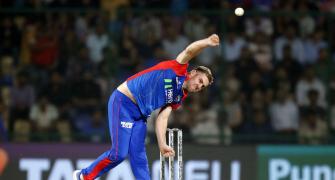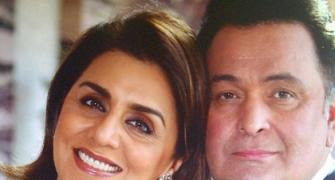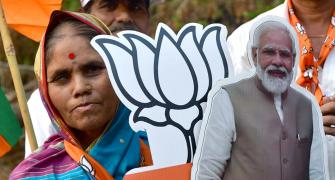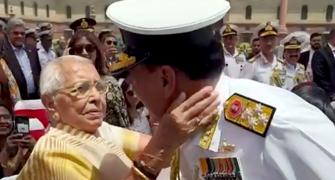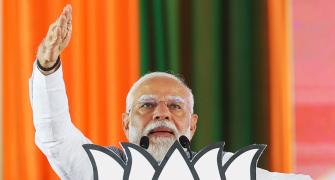As movies go, Mutham (The Kiss) has little to commend it. A bunch of youngsters head off to a resort, intent on exploring their nascent sexuality. And then people begin to die. Whodunit, why, how -- all this forms grist for what is basically a damp squib of a thriller, aimed primarily at the front-benchers and giggly teens.
The movie has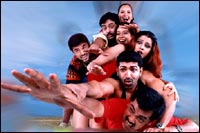 nothing to write home about in terms of story, screenplay, or even performances. Director S A Chandrasekhar -- father, incidentally, of Tamil hero Vijay -- made the film, and Thalaivasal Vijay heads an ensemble cast in a pivotal role, with Arunkumar-Charulata, Nagendra Prasad-Jennifer, and Satyan playing the youngsters.
nothing to write home about in terms of story, screenplay, or even performances. Director S A Chandrasekhar -- father, incidentally, of Tamil hero Vijay -- made the film, and Thalaivasal Vijay heads an ensemble cast in a pivotal role, with Arunkumar-Charulata, Nagendra Prasad-Jennifer, and Satyan playing the youngsters.
And yet, when the history of Indian movies is updated some years hence, Mutham could find a prominent mention -- as the first Indian film to be shot entirely in digital format.
Behind this initiative is M Arul Murthy, who parlayed 15 years of experience in post-production and computer graphics -- including work in India's first ever 3D film My Dear Kuttichathan (Chhota Chetan in Hindi) into Digital Magic, a company he founded in 1997.
Much of the company's work has been in the field of advertising for top-name clients like Rajiv Menon Productions, HTA, Lintas, O&M, Pepsi, Coke and Henko. An 'interest in developing new ideas and methods in television and film media' saw Murthy embark on the production of the digital film.
Digital, he explains, is the way of the future, for a variety of reasons. The technology, as Murthy describes it, sounds a touch too complex for a layman's mind. A concise explanation would be that the scenes are shot in digital format, the material is then digitized to the non-linear editing system; the edited material is then 'on-lined' in a finishing system that digitizes the footage at a higher resolution, which is when the various improvements and/or enhancements -- colour correction, Digital Rotoscopy, matte painting, digital effects, dissolves, wipes, titles, et cetera -- are carried out.
The final output is transferred to 35mm film in Cinemascope format, the negative is processed, and the final print made with picture and sound negative.
All of which, when you think of it, is Greek to the average theatre-goer.
What makes sense, though, is when he talks of the benefits. Murthy says during a career that has seen him do special effects for 35 or more feature films, he kept noticing that much effort -- and money -- went into converting the negative to computer files and then back. 'In normal film-making, shooting in raw film stock costs Rs 20,000 (plus lab
charges) for every 1,000 feet, whereas when you shoot in digital, the cost comes in at Rs 150 for the same footage.'
A film uses up anywhere from 75,000 to 200,000 feet, depending on the budget and the director, so a basic cost comparison makes the biggest advantage of the digital format immediately obvious. First, film budgets are drastically reduced. Secondly, a director can shoot and reshoot to his heart's content till he gets the perfect shot, without driving up costs.
'There are technical benefits as well,' says Murthy. 'For instance, digital cameras can work in low light conditions, thus reducing the need for expensive artificial lighting, and also speeding up shooting, as outdoor work does not have to be halted because of low light. Again, visual effects can be created directly onto the footage, so colour correction, digital effects, Rotoscopy, touch-up and other image improvements can be carried out with greater ease, and far less cost. And these are just some of the basic benefits.'
The key to the exercise is the cameraman in this case, Selva Raja, who says he had a great time. Shooting digital was a new experience for someone used to the traditional film camera. 'For the first couple of days,' he says, 'I found it rather different. I was so used to looking through the viewfinder and seeing the images in true colours, whereas in the digital camera it is in black and white.
'But against that, being able to view the final shot on the professional monitor is a great help. Both the cameraman and
the director can see the final shot as it will appear and so you can fine-tune, or reshoot, and get it right, which gives you great confidence.'
After the first couple of days, says Raja, the unit actually stopped thinking it was working on a different system, and from then on work proceeded at a greater pace. 'The biggest plus is that since we were shooting on digital tape, we could go for the best take without worrying about the raw stock consumption,' he says.
As a film, Mutham is eminently forgettable. But at the technological level, it could turn out to be the trailblazer that changes the way films are shot in India.


